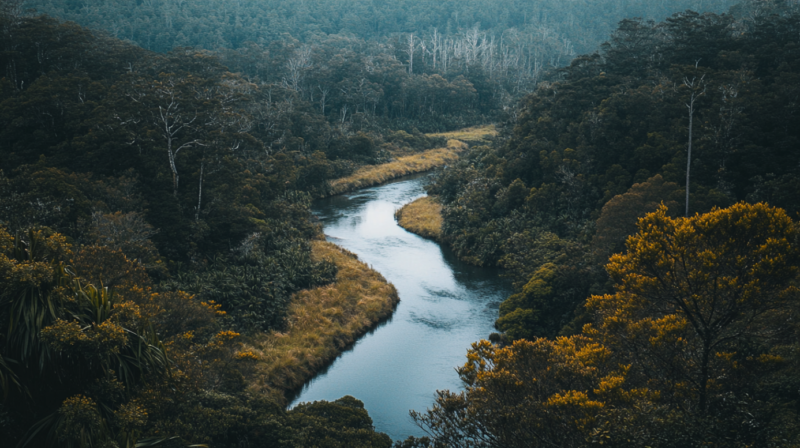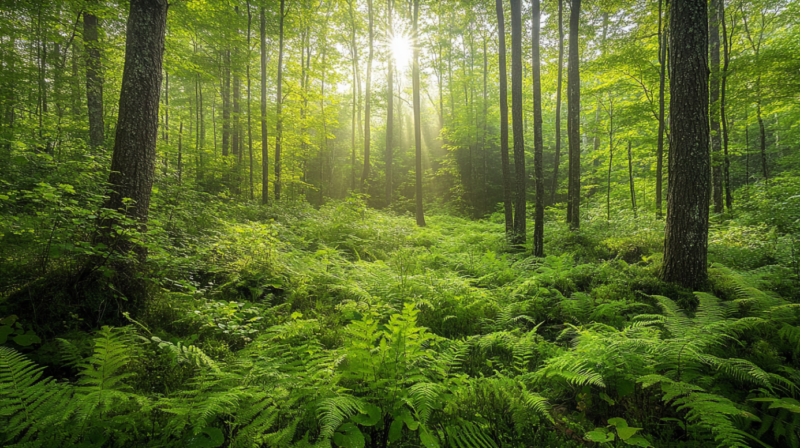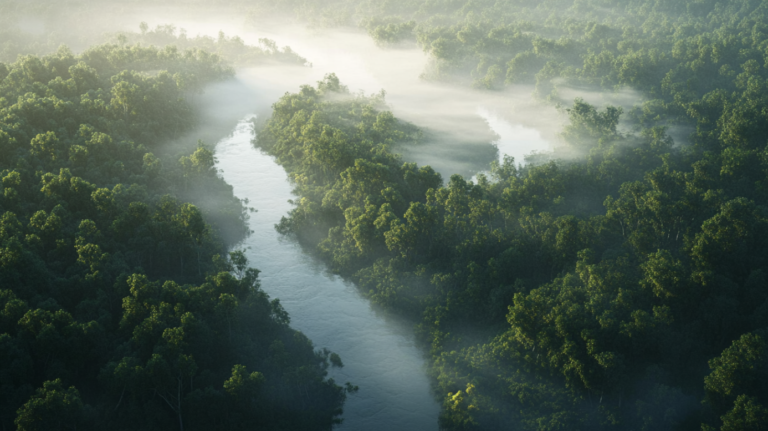Forests, spanning 4.06 billion hectares (31% of Earth’s land), store 861 gigatons of carbon—44% in biomass, 9% in deadwood, and 47% in soil.
They sequester 120 gigatons yearly, offsetting a third of the 10 gigatons from human emissions.
Tropical forests hold up to 200 tons per hectare, boreal and temperate 50-150 tons, but disturbances like wildfires (830 million tons CO₂, Australia 2019-2020) and deforestation (1.5 billion tons, Amazon 2000-2010) release carbon. Managed well, forests could offset 10-20% of emissions by 2050 (IPCC).
The Global Carbon Cycle: A Planetary Balancing Act
The global carbon cycle is Earth’s grand accounting system, tracking the movement of carbon across the atmosphere, land, oceans, and living organisms.
Approximately 120 gigatons of carbon are exchanged annually between terrestrial ecosystems and the atmosphere via photosynthesis and respiration, while oceans absorb another 90 gigatons, according to Fiveable.
Human activities, however, disrupt this balance, adding roughly 10 gigatons of carbon yearly through fossil fuel emissions and deforestation, equivalent to the weight of 2.5 billion elephants.
Forests are linchpins in this cycle. Through photosynthesis, trees absorb CO₂, converting it into oxygen and organic carbon stored in wood, leaves, roots, and soil. This process, termed carbon sequestration, positions forests as vital “sinks,” locking away carbon for decades or centuries.
Yet, forests also release carbon through respiration, decomposition, and disturbances like wildfires or logging, making their net contribution a delicate dance of uptake and emission.
Global Carbon Fluxes (Annual Estimates, Gigatons of Carbon)
Source/Sink
Carbon Input
Carbon Output
Net Effect
Terrestrial Photosynthesis
120
–
Sink
Terrestrial Respiration
–
110
Source
Ocean Uptake
90
88
Net Sink (+2)
Fossil Fuel Emissions
10
–
Source
Deforestation
1-2
–
Source
Sources: IPCC (2021), Global Carbon Project (2023)
Forests as Carbon Reservoirs: A Closer Look
Forests cover about 31% of Earth’s land surface—roughly 4.06 billion hectares—and hold an estimated 861 gigatons of carbon, split across living biomass (44%), deadwood and litter (9%), and soil (47%) as noted by Research Gate.
View this post on Instagram
Tropical forests, like the Amazon, store the most carbon per hectare, followed by temperate and boreal forests. But these numbers only tell part of the story.
Carbon Storage by Forest Type (Tons per Hectare)
Forest Type
Above-Ground Biomass
Below-Ground Biomass
Deadwood
Litter
Soil Organic Carbon
Total
Boreal (Sweden)
35
10
0.85
3.14
45
94
Temperate (UK)
100
28
2.0
3.3
335
468
Tropical (Amazon)
193
47
25
7.3
71
343
The Sequestration Superpower: How Forests Capture Carbon
@minuteearth Planting more trees SOUNDS like a good idea. But if we want to store as much carbon as possible, we need to plant forests – not just trees. #trees #forest ♬ original sound – MinuteEarth
Imagine a single tree as a carbon-capturing machine. A mature oak, for instance, can absorb 48 pounds of CO₂ annually, storing it as roughly 13 pounds of carbon in its wood. Scaled up, a hectare of forest can sequester 2-10 tons of carbon yearly, depending on species, climate, and age.
Young, fast-growing forests excel at sequestration, while old-growth forests excel at storage, holding carbon for centuries.
Soil is the unsung hero here. In boreal forests, up to 70% of carbon resides in organic matter—decaying leaves, roots, and microbes—where it can remain for millennia if undisturbed.
Tropical soils, warmer and wetter, cycle carbon faster, but their sheer biomass compensates. Deadwood, too, plays a role; in Europe, it’s increased from 5 to 10 tons per hectare since 1990, boosting both carbon stocks and biodiversity as noted by Science Direct.
Disturbances: The Wild Card in Carbon Dynamics
Forests aren’t invincible. Natural and human-induced disturbances—fires, storms, pests, and logging—can turn sinks into sources.
The 2019-2020 Australian bushfires released 830 million tons of CO₂, erasing years of sequestration in weeks, according to the Guardian.
Similarly, deforestation in the Amazon, driven by agriculture, released 1.5 billion tons of carbon annually from 2000-2010.
Yet, disturbances aren’t always villains. In boreal forests, fires create mosaics of young and old stands, sustaining biodiversity and long-term carbon cycling.
Managed logging, if sustainable, can maintain carbon stocks by harvesting mature trees and replanting, though it often reduces soil carbon.
Carbon Emissions from Disturbances (Million Tons, 2020 Estimates)
Disturbance Type
Region
Carbon Released
Notes
Wildfires
Australia
830
2019-2020 Black Summer
Deforestation
Amazon
1,500
Annual average, 2000-2010
Logging
Europe
200
Sustainable practices
Managing Forests for Carbon and Beyond

Forest management is a tightrope walk between carbon goals and ecological health. Here’s how strategies play out:
- Afforestation: Planting trees on degraded land—like Europe’s 5% forest expansion per decade—boosts carbon stocks. Spontaneous regrowth, as in Mediterranean abandoned pastures, adds biodiversity bonuses but grows slower.
- Silviculture: Extending rotation periods (e.g., from 50 to 80 years) in semi-natural forests increases carbon in big trees and deadwood, benefiting species like woodpeckers. Europe’s wood volume has risen 30% since 1990 due to such practices.
- Fire Management: Controlled burns in boreal forests mimic natural cycles, enhancing carbon storage and habitat diversity, though intense fires must be curbed.
- Plantations: Fast-growing exotics like eucalyptus sequester carbon quickly—up to 20 tons/ha/year—but risk biodiversity loss if invasive, as seen in Ireland’s 87% plantation cover.
Biodiversity: The Carbon Connection
Carbon and biodiversity are intertwined. Diverse forests—rich in species and structures like deadwood—store more carbon stably. Soil fauna, like springtails, break down litter, locking carbon underground.
Yet, intensive management (e.g., nitrogen fertilizers) can favor nitrophilous plants, reducing diversity and soil health, as seen in Europe’s darkening forests.
Biodiversity vs. Carbon Trade-offs
Strategy
Carbon Impact
Biodiversity Impact
Nitrogen Fertilization
+ (Growth boost)
– (Species loss)
Deadwood Retention
+ (Storage)
+ (Habitat gain)
GMO Plantations
+ (Fast sequestration)
– (Genetic risks)
Future Prospects: Forests in a Warming World

IPCC notes that by 2050, forests could offset 10-20% of global emissions if managed wisely, per IPCC models. Protecting primary forests, expanding semi-natural stands, and curbing deforestation are key.
Yet, climate change itself—warmer temperatures, droughts, and pests—threatens this potential.
The Amazon risks becoming a savanna, releasing its carbon hoard. Policy must balance carbon goals with biodiversity, avoiding pitfalls like GMO trees, which the UN’s CBD flagged as risky in 2006.
Conclusion
Forests are nature’s climate warriors, bridging the gap between human excess and planetary resilience. Their role in the carbon cycle—sequestering CO₂, storing it in vast reserves, and cycling it through ecosystems—is a testament to their power.
With informed management, they offer hope—a green shield against a warming world. But their fate rests on us: will we nurture these guardians or squander their gifts?

